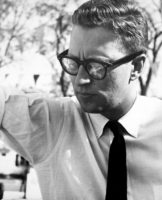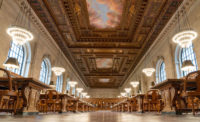 |
| Image courtesy Gunnar Birkerts |
The Latvian National Library was conceived in 1991, the same year Latvia gained independence from the Soviet Union. |

Gunnar Birkerts, FAIA, a Latvia native now based in Massachusetts, won the commission to design the Latvian National Library in 1991—the same year the country gained independence from the Soviet Union. But the high-profile project never got off the ground due to funding woes.
Now, nearly two decades later, construction of the library is finally under way in the capital city of Riga. Given that Latvia has been hit hard by the economic crisis, “it’s really amazing that the project is still moving forward,” Birkerts says. Equally amazing is the fact that Birkerts’s original design has been maintained. “There has been enormous change within the building,” Birkerts says, “but the shell has not changed.
The architect conceived an asymmetrical “glass mountain” inspired by a Latvian folktale about three men scaling a glass mountain on horseback to rescue an imprisoned princess. The story, and his design, are related to Latvia’s quest for independence. “It’s a fable that absolutely everybody knows. And it was expressive of the political situation at the time, breaking away from the Soviets to strike out on our own as a nation.”
Large expanses of glass on the facades will be combined with stainless-steel walls and roofs. Inside, the 13-story library will contain six million books overlooking an atrium. Completion is slated for 2012.
The $300 million building, designed in collaboration with local architect Modris Gelzis, is rising on the banks of the Daugava River, facing Riga’s historic center. It will anchor a new development that includes a government center, university buildings, and a concert hall. The location is part of an effort “to keep developers out of the Old Town,” says Birkerts. “We are doing this with the help of UNESCO, which has declared Old Riga a protected area.”
Birkerts turned 85 this year, and this project caps a long career commemorated in the new monograph, Gunnar Birkerts: Metaphoric Modernist, published by Axel Menges. After studying in Stuttgart, Bikerts worked in the offices of Eero Saarinen and Minoru Yamasaki before establishing his own practice outside of Detroit in 1962. Among his best-known works are the Federal Reserve Bank of Minneapolis (1973), the Kemper Museum of Contemporary Art in Kansas City (1994), and the Corning Museum of Glass (1980), in Corning, New York. Currently, he is working on the renovation and enlargement of the Museum of the Occupation of Latvia in Riga.
Editor's Note: This story has been updated.


